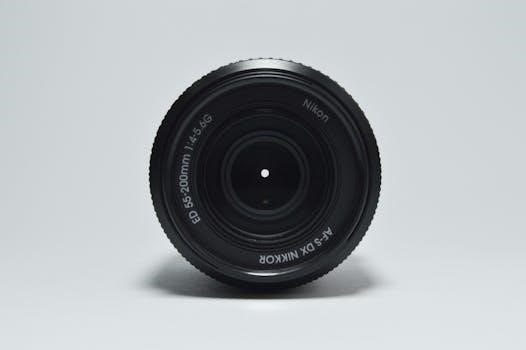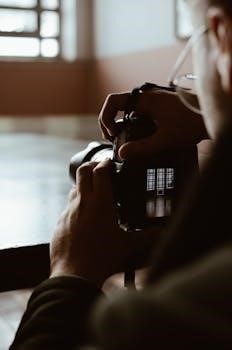Nikon D3300 Owners Manual Overview
This section provides an overview of the Nikon D3300 owner’s manual. It introduces the camera’s features, settings, and practical usage. The manual is available in PDF format for easy access, detailing camera controls, shooting modes, and maintenance.
The Nikon D3300 is a digital SLR camera designed for both beginners and enthusiasts, offering a blend of user-friendly features and advanced capabilities. This camera boasts a 24.2-megapixel CMOS sensor, ensuring high-resolution images with excellent detail and clarity. The D3300 is a popular choice due to its compact and lightweight body, making it easy to handle and carry around. It provides various shooting modes, including scene modes for specific situations and manual controls for more experienced users. Its intuitive interface and helpful guides make it easy for new users to quickly familiarize themselves with the camera. The D3300 is compatible with a wide range of Nikon lenses and accessories, allowing for diverse photographic expression and creativity. A key feature is its ability to record high-definition videos, providing additional multimedia functionality. This introduction will guide you through the basic functions and benefits of the D3300.
Downloading the User Manual
Accessing the Nikon D3300 user manual is straightforward, with multiple options for downloading it. The manual is typically available as a PDF file, which can be viewed on computers, tablets, and smartphones. Nikon provides the official manual on their website, under the support section for the D3300. You can also find the manual on various third-party websites that host camera manuals. Downloading the PDF version allows you to save it locally and access it offline, providing a convenient reference. The Nikon Manual Viewer 2 app, available for both iOS and Android, offers another way to access the manual on your mobile device. Ensure that you have Adobe Reader or a compatible PDF viewer installed to open the manual. Always download from reputable sources to avoid malware. The manual often includes both a basic user manual and a more in-depth reference manual.

Key Features and Settings
This section explores the key features and settings of the Nikon D3300. It covers the camera body, controls, shooting modes, focusing, and exposure. Understanding these elements is crucial for effective photography.
Understanding the Camera Body and Controls
The Nikon D3300 features a well-designed body with intuitive controls. Key components include the mode dial, which allows selection of shooting modes like Program, Shutter-priority, Aperture-priority, and Manual. The camera body also houses the shutter-release button, command dials for adjusting settings, and the movie-record button for video capture. The built-in flash and hot shoe for external flashes are essential for various lighting scenarios. The lens mount allows for interchangeable lenses, and the body cap protects the sensor when a lens isn’t attached. Additional features like the AF-assist illuminator, microphone, and connector for external microphones provide extra functionality. The LCD screen displays information and enables menu navigation. Understanding the location and function of each button, dial, and port is crucial for effectively using the D3300. Moreover, the viewfinder with diopter adjustment allows users to have a clear view of the scene. The rubber eyecup helps for comfortable viewing.
Exploring Shooting Modes
The Nikon D3300 offers a variety of shooting modes to cater to different photographic needs. The mode dial provides access to Program (P), Shutter-priority (S), Aperture-priority (A), and Manual (M) modes, giving users control over exposure settings. Scene modes are available for specific situations like Portrait, Landscape, Child, Sports, Close up, and Night Portrait. Special Effects modes, including Night Vision, Super Vivid, Pop, Silhouette, Selective Color, and High Key, allow for creative image capture. These modes simplify shooting by automatically adjusting settings for optimal results. Furthermore, the camera has a guide mode that is useful for beginners. Selecting the appropriate mode for your subject or situation is important for capturing the best possible image. Each mode offers unique advantages and is tailored to enhance specific photographic styles. Understanding these modes is key to mastering the D3300.
Focusing and Exposure Settings
The Nikon D3300 provides various focusing and exposure settings to achieve sharp and well-exposed images. The camera offers different focus modes, allowing users to choose how the camera focuses. AF-area modes determine how the focus point is selected. Exposure settings include metering modes to measure light, along with options for adjusting shutter speed, aperture, and ISO. Users can select Programmed Auto (P), Shutter-Priority Auto (S), Aperture-Priority Auto (A), or Manual (M) modes to control exposure. The camera also features exposure compensation for fine-tuning brightness. Understanding these settings is essential for taking well-exposed photos in varied lighting conditions. Proper use of focusing and exposure settings ensures clear, sharp, and vibrant images. Additionally, the camera has an auto-focus assist illuminator for focusing in low light. These controls greatly enhance the user’s ability to capture high-quality images.

Practical Usage and Maintenance
This section covers practical aspects of using the Nikon D3300, including recording, viewing images and videos, connecting to devices, and troubleshooting. It also emphasizes safety precautions and proper camera maintenance.
Recording and Viewing Images and Videos
The Nikon D3300 allows users to easily record both still images and high-definition videos. To capture photos, utilize the camera’s various shooting modes and focus settings to achieve the desired results. After capturing, images can be viewed in full-frame or thumbnail modes, with options to display detailed photo information.
For recording videos, the D3300 offers multiple movie settings, allowing for customization of video quality and frame rates. Once recorded, videos can be played back directly on the camera’s screen. The manual also explains how to edit videos, including trimming and saving selected frames. Furthermore, users can learn how to connect the camera to external devices for larger viewing experiences or for transferring images and videos for external storage. Understanding these aspects ensures that users can effectively capture and review their creative work. The manual provides step-by-step instructions for navigating these functions.
Connecting to Other Devices and Printing
The Nikon D3300 allows for seamless connectivity with other devices, enhancing its versatility. The manual explains how to connect the camera to computers for transferring photos and videos, often using the provided software or USB connections. It details the process of installing necessary software, like ViewNX 2, and how to use it for image management and viewing. Additionally, the guide covers connecting the D3300 to televisions for larger display of media, allowing users to share their photos and videos.
Furthermore, the manual provides instructions on how to print photographs directly from the camera. It covers connecting to compatible printers and creating DPOF print orders for batch printing. Users can learn to print single images or multiple ones and adjust printing settings for best results. This functionality allows users to take their digital images from the camera to physical prints with ease. The guide ensures users are capable of effectively sharing their work beyond the camera’s screen.
Troubleshooting and Safety Precautions

The Nikon D3300 owner’s manual includes a vital section on troubleshooting common issues and emphasizing safety precautions. This part of the manual helps users diagnose and resolve problems that might arise during camera operation. It addresses issues such as error messages, focus problems, and difficulties with image playback. The manual offers step-by-step guidance on how to rectify these problems, ensuring a smooth user experience. Additionally, it covers how to properly care for the camera, including cleaning and storage tips to prevent damage.
The safety portion of the manual outlines crucial precautions to avoid injury and damage to the device. It stresses the importance of using only Nikon-approved accessories, particularly batteries and chargers, to prevent malfunctions or hazards. The manual advises on safe handling of batteries, and the risks associated with improper charging. It includes warnings about not placing the strap around infants’ necks, observing precautions when photographing them. This focus on safety ensures users operate the camera responsibly.

Advanced Features and Customization
This section explores the advanced capabilities of the Nikon D3300, focusing on features like the retouch menu for image adjustments and the selection of optional accessories and lenses to enhance photographic experiences.
Exploring the Retouch Menu
The Nikon D3300’s Retouch Menu offers a range of in-camera editing options to enhance your photos without needing external software. You can access this menu to modify existing images, creating copies with applied effects. The D-Lighting feature helps to balance exposure, recovering details in shadows and highlights. Red-eye correction can be applied to fix portraits affected by flash. The Trim option allows for cropping images to improve composition. You can also convert color photos to monochrome or apply various filter effects. There’s also a color balance option to adjust hue and saturation. The Image Overlay feature lets you combine two NEF images into one. For RAW images, the NEF processing tool can convert them to JPEGs with customizable settings. You can also resize images and use quick retouch for minor adjustments. These features provide a versatile editing suite within your camera.
Optional Accessories and Lenses
The Nikon D3300 is compatible with a range of optional accessories and lenses, expanding its functionality and creative potential. You can explore various NIKKOR lenses, including both CPU and non-CPU types. CPU lenses allow for full camera control, while non-CPU lenses require manual settings. Optional flash units, such as Speedlights, can be used to enhance lighting in various situations. The camera also supports other accessories like external microphones for improved audio recording. Additionally, you can use power connectors and AC adapters for extended shooting sessions. It’s essential to use only Nikon-certified accessories to ensure compatibility and safety. Memory cards are also a vital accessory for storing your photos and videos. By exploring these options, you can greatly enhance your photography experience with the Nikon D3300.


